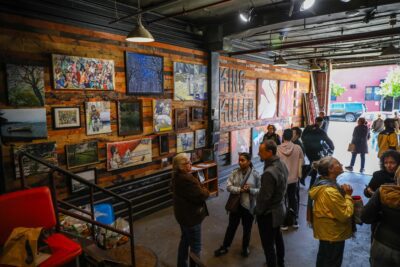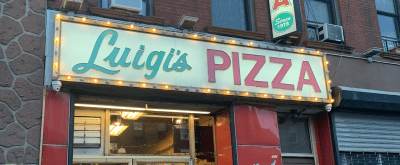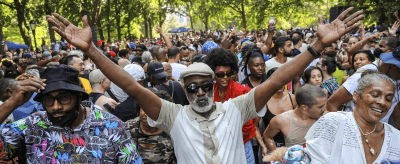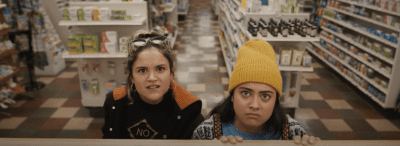Crowd at talon TV eye show (Andrew Hallenberg)
Inside the queer punk revolution
A massive post-pandemic wave of queer bands is making New York the underground scene to watch again
Purgatory is at capacity.
It’s sweaty. It’s sold out. And it’s increasingly topless.
The evening’s emcee at the Bushwick venue, a drag queen named Evangeline, is urging the band, a trio of trans women called Crush Fund, to keep playing even though they’ve finished their set and are unplugging their instruments. The crowd has been moshing and clearly wants more.
So Evangeline issues a simple command.
“These girls are up here giving it their all. Take your shirts off with them! And let’s have them play one more fucking song!”
The crowd complies. The band — all of whom had taken off their own dresses to cope with the heat — plays one last song: a barn burner called “Seeing Stars.”
“Everyone is dancing, losing their minds, with their tits out,” says bassist July Brown.
The show, now in the distant past of March, lives on. It encapsulates the intense energy of the past year, during which Brooklyn has seen an explosion of ambitious queer and trans rock bands.
“That was a ‘what we’re doing is touching other people’ moment,” says Crush Fund drummer and singer Nora Knox.
They’re not alone. Not a few bands and bookers in the scene are calling it an unprecedented cultural movement that could produce national-level buzz of the kind that surrounded New York’s last hyped scene in the early 2000s.
It’s hard to estimate just how many bands the underground queer scene has because there are scenes within scenes — such as “tranny punk,” as they call it, and another with more lesbian-fronted bands. In March, a Queens pop-up called Dave’s Lesbian Bar hosted a battle of the bands with 16 queer groups. Hazel Cederquist, a booker at Purgatory, one of the scene’s home-base venues and one of only a few queer-owned and operated bars in Brooklyn, identified a core of five or so bands that are leading the charge in terms of visibility and popularity — including Crush Fund, Uncle Pizza and Pop Music Fever Dream.
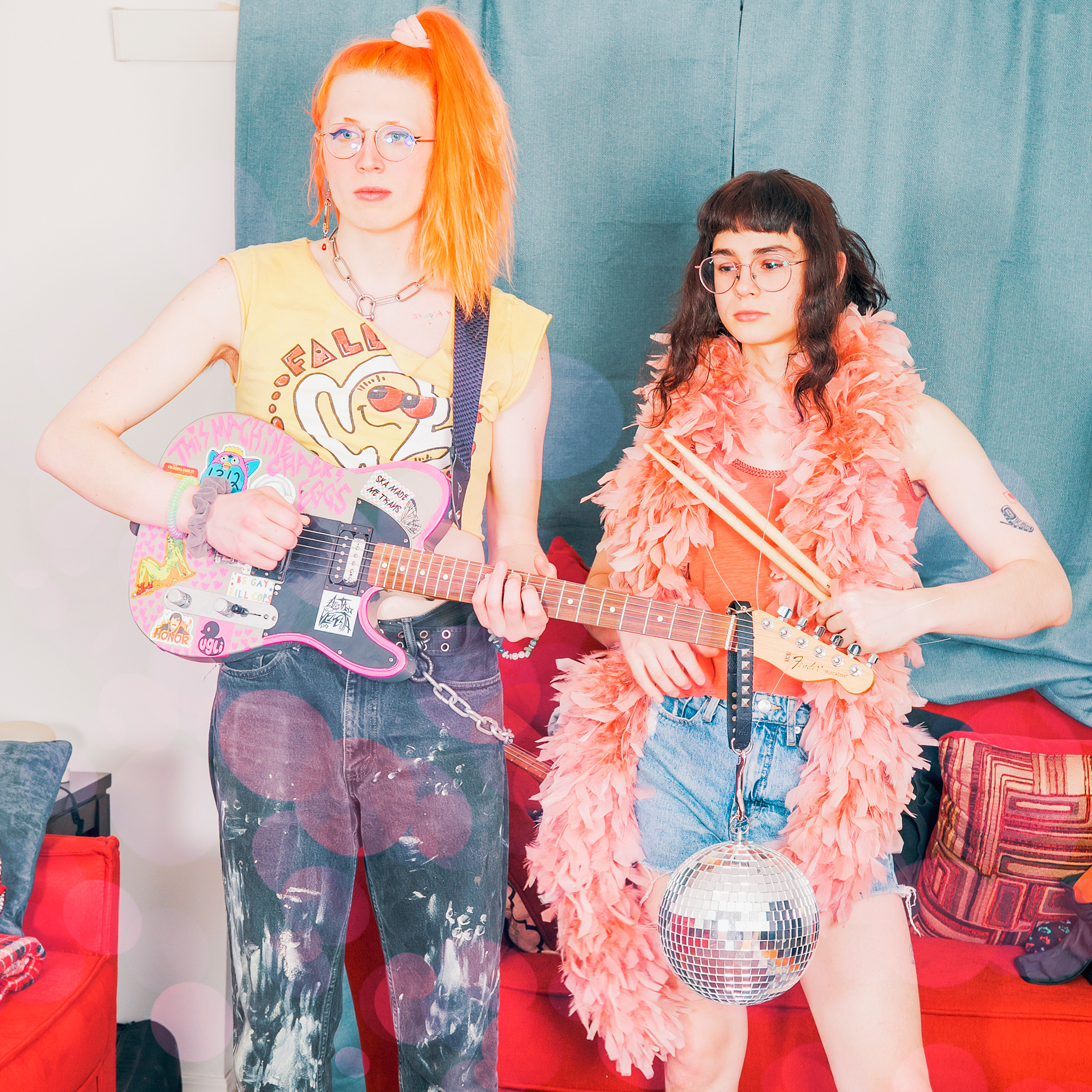
Wendy Kya and Nora Knox of Crush Fund (Pat Plush Photos)
But there are countless others, and seemingly more every month; another group that Cederquist points to as a leader in the scene, Spare Feelings, had not even released any music online as of the interview, having just formed a few months earlier.
“It’s impossible to answer because it’s so nebulous,” says Cederquist, who also performs in drag under the excellent name [unintelligible screaming].
“Trying to define any scene as ‘the queer music scene’ — it’s just so widely spread, and there’s different subgroups and subcategories. It’s just impossible to put a number on.”
The overarching feeling, though, is that something special is brewing, and that some of the groups could soon blow up.
“We’re very much a lot like the scene 20 years ago, with the Yeah Yeah Yeahs, LCD Soundsystem,” says Crush Fund guitarist and singer Wendy Kya.
A punk ethos
The artists involved often mix and match genres, from post-punk to hyperpop to emo to folk. Crush Fund mixes the tight rock of a band like Yard Act with the unpredictable distorted pop of 100 gecs. Pop Music Fever Dream channels the spoken-word humor of Parquet Courts and the avant-garde energy of Sonic Youth. AVATAREDEN melds Latin beats and sounds with contemporary indie rock. Talon takes from bedroom pop rock and, in their words, a bit of Sheryl Crow.
But multiple bands interviewed say that what unites them is a punk ethos and ideology centered on being proudly open about their identities and focused on cultivating tight-knit communities.
These girls are up here giving it their all. Take your shirts off with them! And let’s have them play one more fucking song!— Evangeline
“Those kinds of genre boundaries aren’t so important when we can have a shared identity of being queer and trans,” says Knox.
“While punk is a genre, ‘punk’ represents DIY, anti-establishment, anti-consumerism,” says Eden Quintero, who leads AVATAREDEN. “So, when I hear ‘queer punk,’ sonically, I’m in for a surprise, but I almost know the folks playing will be representing these ideas in their music for the most part.”
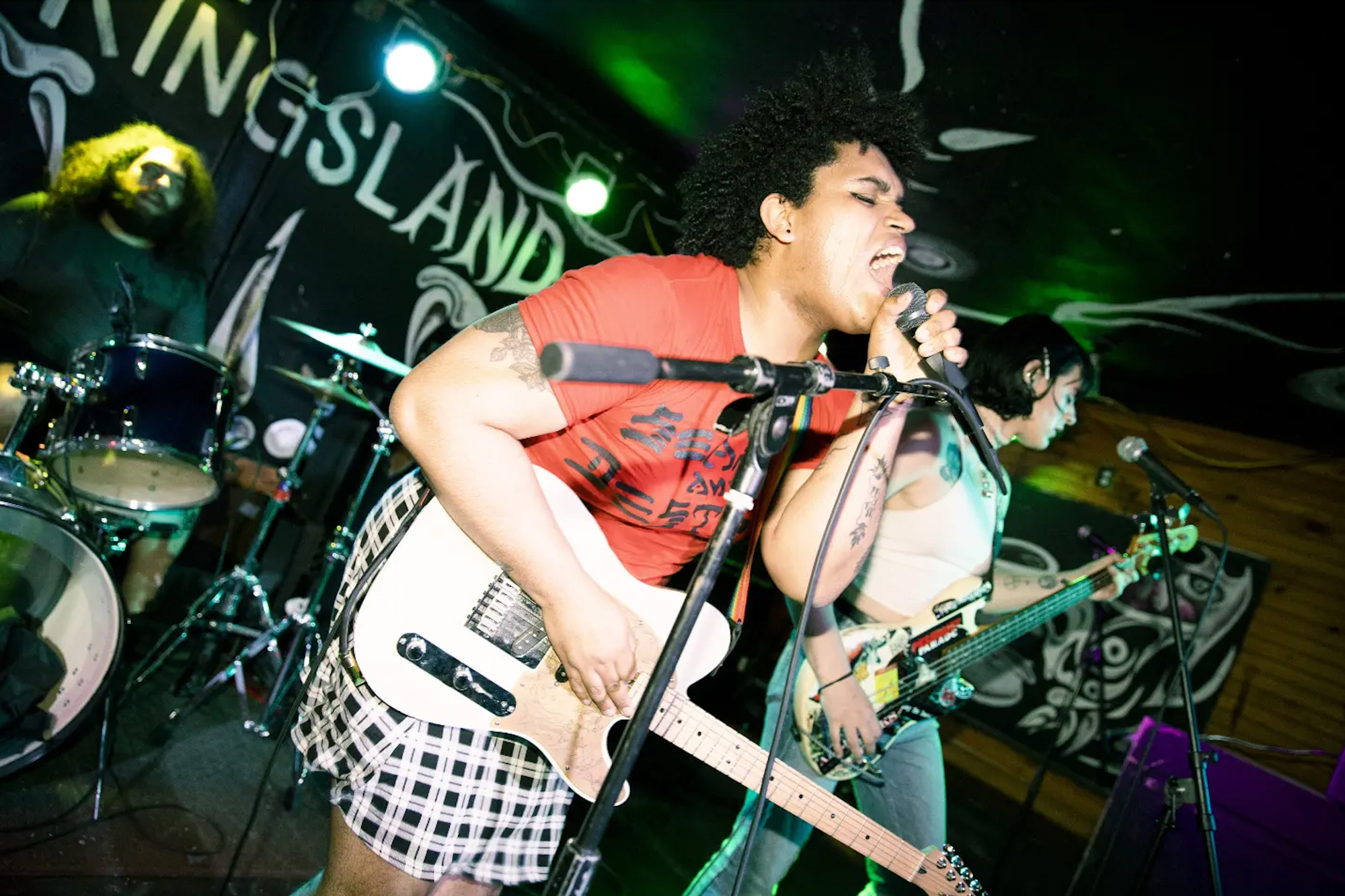

Eevie Echoes and The Locations (Tori McGraw/@afterr.hourrs on Instagram)
As pushback mounts against the LGBTQ+ community, including proposed nationwide legislation that targets their very existence, these artists have a goal of putting their identities and personal struggles in your face through their direct lyrics and rambunctious live shows.
Another goal is to create solidarity and encourage others to join the scene — and to keep the momentum going.
“If I can create like 10 more Crush Funds because of what we do, that’s the goal. And if one of them becomes huge and gigantic and eats us alive — that’s a dream,” says Knox.
The lockdown effect
Many of the bands were formed after the initial 2020 Covid lockdown, amid a well-documented wave of people across the country coming out. And many moved to New York from other cities, from as far as Los Angeles, to pursue their music goals.
Eevie Garcia, for example, who fronts punk group Eevie Echoes and the Locations, transitioned during that time.
“I’d been playing music since I was younger, but I picked up the guitar over quarantine and started writing songs,” she says. “And so, the project was kind of born out of just needing a place to put all these feelings that I was having.”
Tim Seeberger, the leader of Pop Music Fever Dream (which won the aforementioned battle of the bands) and whose pronouns are they/he, lived in Massachusetts in the early stage of the pandemic.
“When I moved [to New York], I was like, ‘Okay, it’s time for me to do this music thing. I can’t not do it any longer,’” says Seeberger, who had been dreaming of starting PMFD, as their fans affectionately call it, for a few years.
All the artists who talked with Brooklyn Magazine spoke at length about how the scene extends beyond the music. Many are friends outside of band practice and join several other bands within their sub-scene, or fill in when a member of a group is out of town or sick.
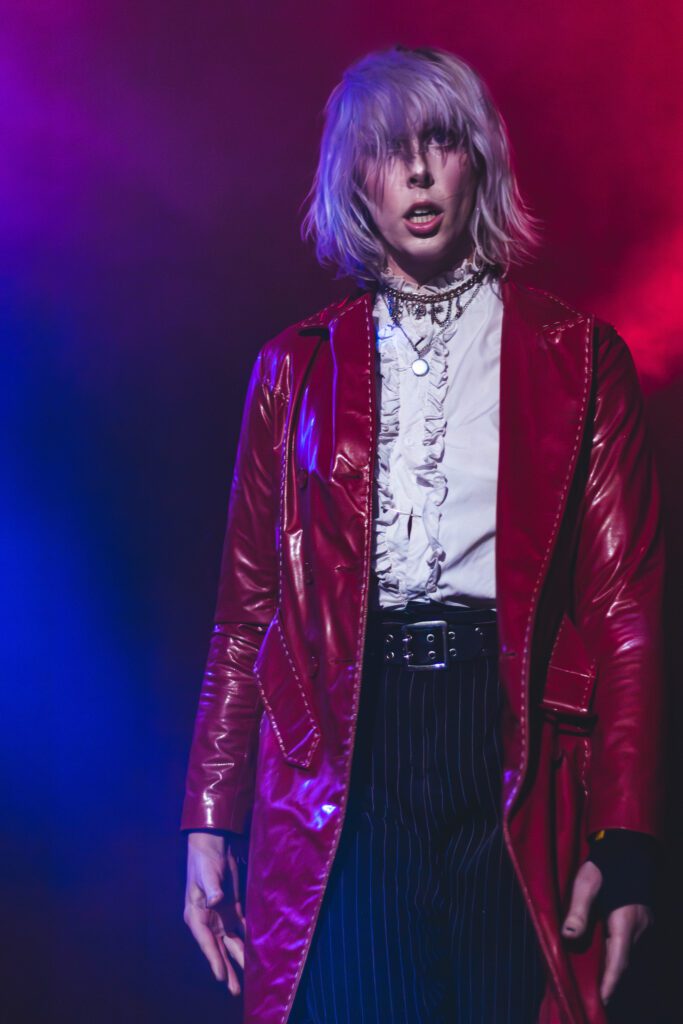

Hazel Cederquiest as [unintelligible screaming] – (camera.c02_Instagram)
There isn’t an atmosphere of competition — between themselves locally or with the enormous, disconnected ecosystem of bands around the world trying to amass followings on Spotify or TikTok. They all promote each other’s shows, invite each other onto bills and look forward to each other’s performances at places such as Purgatory and Gold Sounds Bar, or at DIY “venues” such as the Wet Spot and the Wooden Cat. Those latter shows often happen in the backyards of Bushwick apartment buildings (and sometimes attract cops, who break up the fun).
Hidden from the street on a stretch of BQE-shadowed Broadway in South Williamsburg, a small door leads down a flight of steps into a tight basement that has been turned into a rehearsal space for several groups. It’s cramped with multiple bands’ worth of equipment, and the walls are lined with brightly colored light bulbs on strings. Members of two of the bands, Talon and Angel Hair No. 12 — seven people in total — are taking a lunch break before they trade places in the room.
“It’s like a nice little family, where we can always kind of hop around,” says Zena Marie, who is the bassist in Talon and also the lead singer of Angel Hair No. 12, which blends Mitski-esque melody with psychedelic rock.
The focus is more on selling out their local shows than growing their Spotify streams. Talon’s MK Charron says when the band met someone who does A&R for the Secretly Group — an umbrella of three labels that are home to some of the biggest names in indie rock — her main piece of advice was to focus on building “an organic audience” in New York.
Another pandemic effect is still adding to the energy surrounding the scene: Fan enthusiasm for live shows has hit a high after slowly working its way back from the lockdown era lows. Concertgoers aren’t taking the moment for granted.
“All these bands are under, like, 2,000 followers [on Instagram] right now, in this immediate scene,” says Kya. “To have so many people in the audience be that excited for these bands that are this small, I think just really speaks something to what is happening in trans punk communities across the country, and the queer music scenes, and just a revival of the New York music scene — just the power of fucking gigging your ass off in New York, playing incredibly sweaty shows.”
Cover of the Rolling Stone?
In the early 2000s, the bands that Kya mentioned — The Yeah Yeah Yeahs and LCD Soundsystem — in addition to others, such as The Strokes and Interpol, promoted themselves in a pre-internet era with pre-internet techniques like word of mouth and posters. The feeling in this contemporary scene, at least, is that the global obsession with streaming numbers and social media promotion has triggered a backlash, and more bands want to get back to a more in-real-life fan-building process.
No matter what else is going on in the world, we have this, and we have made this— Wendy Kya
“I use Instagram, but I also think social media is poison for my brain,” Cederquist says. “So I do the vast majority of my promotion physically — I hand out physical flyers at events, I put flyers up on telephone poles, especially outside subway stations. It’s been a huge success.”
Cederquist believes the scene could just create a circuit of venues all on their own. Dave’s Lesbian Bar, for example, which has run pop-up events for years, is now looking for a brick-and-mortar space in Queens.
“This is a full movement that is happening, and I don’t think it has to even be a part of anything else to be special,” Cederquist says. “It does have the power to organically grow.”
But very few of the scene’s denizens anticipate national-level fame — like, say, being featured on the cover of Rolling Stone, or, in the case of queer band MUNA, opening for Harry Styles and Taylor Swift. Not that some would mind.
“I’m kind of okay with trans affirmation and trans success being trendy, considering everything else that’s going on!” says Brown, laughing.
Though there is the possibility that that kind of attention throws a band “in the toilet,” as Seeberger says — a kind of death-by-spotlight. Still, there are positive aspects to being appreciated.
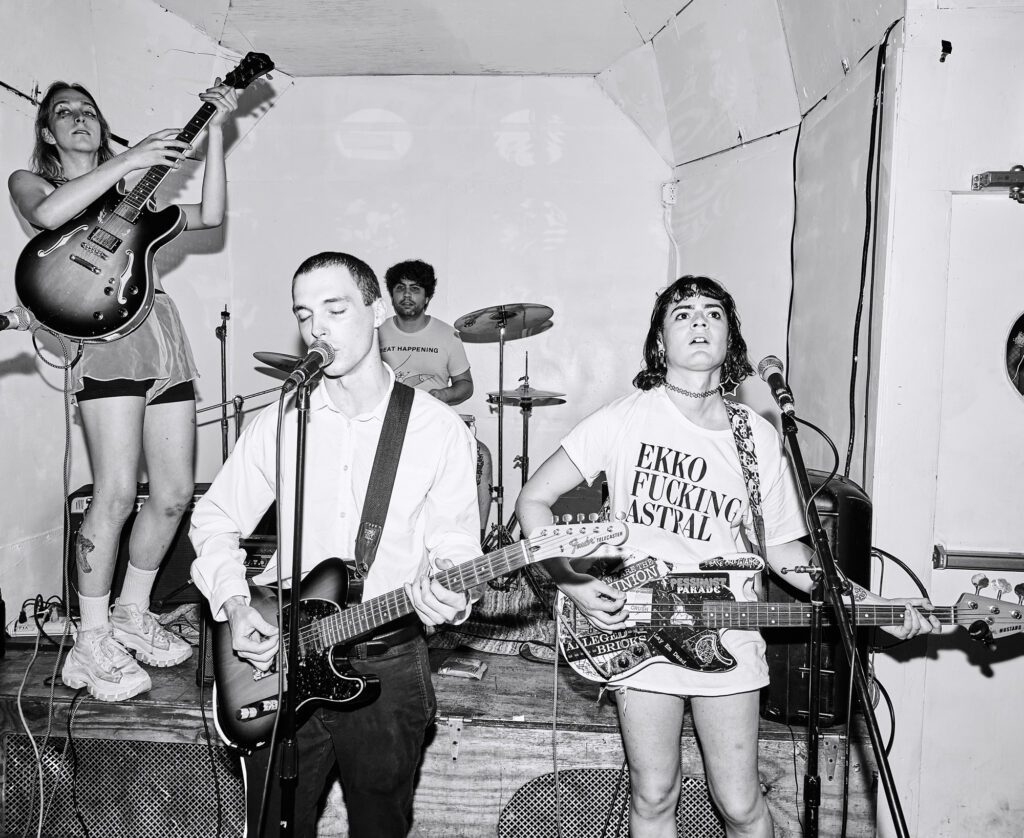

Pop Music Fever Dream (Michelle LoBianco)
“If I can get some queer kid in Indiana who’s in the closet as a 17-year-old because there are no resources for him or anything like that, and he can hear a song I made, and look at a picture of the band, where you have someone who identifies as non-binary, a queer person, two trans women and a cis straight man drumming,” says Seeberger, “it would mean so much to me.”
Seeberger remembers a rock star scene from the Dave’s Lesbian Bar battle of the bands: PMFD took the stage after over a dozen other bands had already played, and as soon as Seeberger and company plugged in, a thick thunderstorm arrived. Over a hundred fans streamed into the main hall at the Bohemian beer garden in Astoria and went wild as Seeberger unleashed what they call their “manic energy.” During a bandmate’s guitar solo, Seeberger ran to the back of the hall and stood on the merch table screaming, “THIS IS WHERE OUR MERCH IS! IT’S 20 BUCKS FOR A SHIRT!”
Over the course of just three songs in the first round, Seeberger felt like a festival headliner.
“No matter what else is going on in the world, we have this, and we have made this,” Kya says. “How far can we take it?”
This article originally appeared in the fall/winter 2023 issue of Brooklyn Magazine. Want it delivered to your door for a nominal fee (plus a free hat)? Click here to subscribe.
You might also like 

















